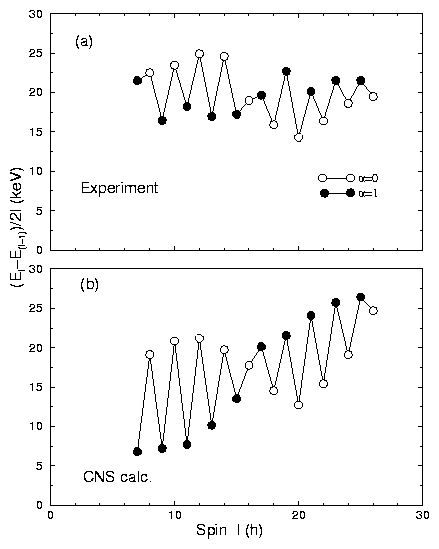| Signature Inversion Caused by Triaxiality in the 72Br Nucleus B, E | |||
|---|---|---|---|
| C. Plettner1, I. Ragnarsson2, H. Schnare, R. Schwengner, L. Käubler, F. Dönau, A. Algora3, G. de Angelis3, A. Gadea3, D.R. Napoli3, J. Eberth4, T. Steinhardt4, O. Thelen4, M. Hausmann5, A. Müller5, A. Jungclaus5, K. P. Lieb5, D.G. Jenkins6, R. Wadsworth6, A.N. Wilson6 | |||
|
Rotational structures in nuclei can be characterized by the signature quantum number a which defines the admissible spin sequence for a band through the relation I = a+ 2n (n = 0, 1, ...). This is a consequence of the well-known D2-symmetry of deformed intrinsic shapes reflected by the appearance of two signature partner bands with a = 0 or 1 in even-mass nuclei. By investigating the relative position of the signature partners, important information about the structural changes ocurring in the nucleus with the increasing spin can be gained. 
Fig. 1 Energy difference between the states with spin
I and spin (I - 1), divided by 2I, for the observed (upper panel)
and calculated (lower panel) negative-parity bands in 72Br.
A peculiar feature of the negative-parity bands in 72Br is the signature
splitting that can be seen in the upper panel of Fig. 1. The a = 1
branch is favoured up to I » 16 where a crossing of the branches takes
place such that the a = 0 branch is favoured at higher spins.
This signature inversion in the negative-parity bands is unique in the
chain of the odd-odd Br isotopes. In contrast, the 74,76,78Br nuclei
display signature inversions in the positive-parity bands at lower spin values
of 9,10,11, respectively.
1 FZR and Horia Hulubei NIPNE, Bucharest, P.O. Box MG-6, Romania
References
[1] I. Ragnarsson et al., Phys. Rev. Lett. 74, 3935 (1995)
[2] C. Plettner et al., Phys. Rev. Lett. 85, 2454 (2000)
|